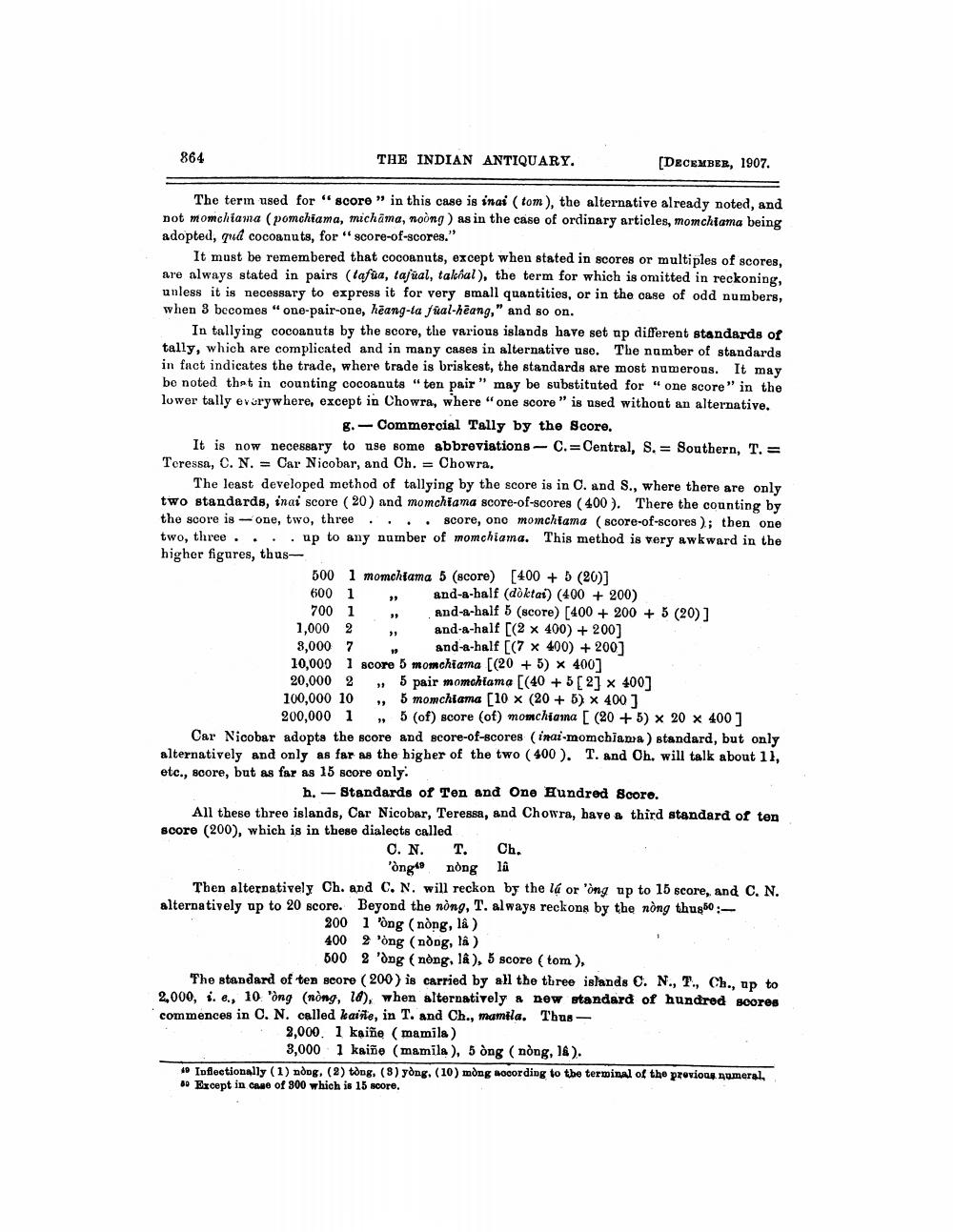________________
THE INDIAN ANTIQUARY.
The term used for "score" in this case is inai (tom), the alternative already noted, and not momchiama (pomchiama, michama, noòng) as in the case of ordinary articles, momchiama being adopted, qua cocoanuts, for "score-of-scores."
864
It must be remembered that cocoanuts, except when stated in scores or multiples of scores, are always stated in pairs (tafua, tajual, takial), the term for which is omitted in reckoning, unless it is necessary to express it for very small quantities, or in the case of odd numbers, when 3 becomes "one-pair-one, heang-ta fual-heang," and so on.
In tallying cocoanuts by the score, the various islands have set up different standards of tally, which are complicated and in many cases in alternative use. The number of standards in fact indicates the trade, where trade is briskest, the standards are most numerous. It may be noted that in counting cocoanuts "ten pair" may be substituted for "one score" in the lower tally everywhere, except in Chowra, where "one score" is used without an alternative.
g. Commercial Tally by the Score.
It is now necessary to use some abbreviations- C. Central, S. Southern, T. = Teressa, C. N. Car Nicobar, and Ch. Chowra.
The least developed method of tallying by the score is in C. and S., where there are only two standards, inai score (20) and momchiama score-of-scores (400). There the counting by the score is one, two, three.... score, ono momchiama (score-of-scores); then one two, three. up to any number of momchiama. This method is very awkward in the higher figures, thus
.
500 1 momchiama 5 (score) [400 + 5 (20)]
600 1
and-a-half (doktai) (400 + 200)
[DECEMBER, 1907.
and-a-half 5 (score) [400+ 200+ 5 (20)] and-a-half [(2 x 400) + 200]
700 1 1,000 2 3,000 7 10,000 1 score 5 momchiama [(20 + 5) × 400]
and-a-half [(7 x 400) +200]
19
5 pair momchiama [(40+5[2] x 400]
33
20,000 2 100,000 10 200,000 1
5 momchiama [10 x (20+ 5) x 400 ]
5 (of) score (of) momchiama [ (20+5) x 20 x 400]
Car Nicobar adopts the score and score-of-scores (inai-momchiama) standard, but only alternatively and only as far as the higher of the two (400). T. and Ch. will talk about 11, etc., score, but as far as 15 score only.
h. Standards of Ten and One Hundred Score.
99
29
35
All these three islands, Car Nicobar, Teressa, and Chowra, have a third standard of ten score (200), which is in these dialects called
C. N. T. òng nòng
Ch. lâu
Then alternatively Ch. alternatively up to 20 score.
300
and C. N. will reckon by the lá or 'òng up to 15 score, and C. N. Beyond the nong, T. always reckons by the nòng thus50:1òng(nòng, là ) 400 2òng (nòng, lên )
500 9’òng(nòng, lê), 5 score ( tom ),
2,000, i. e., 10. "òng commences in C. N.
The standard of ten score (200) is carried by all the three islands C. N., T., Ch., up to (nong, la), when alternatively a new standard of hundred scores called kaine, in T. and Ch., mamila. Thus2,000. 1 kaiñe (mamila)
3,000 1 kaiñe (mamila ), 5 òng ( nòng, lên ).
Inflectionally (1) nòng, (2) tòng, (8) yòng, (10) mong according to the terminal of the previous numeral, 80 Except in case of 300 which is 15 score.




